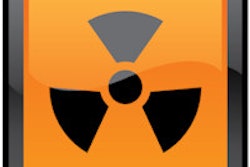
The long-awaited radiation survey from the Netherlands has shown that imaging sites in the country have moderate dose levels in CT compared with other European nations. But it also indicates a wide variability among the 21 hospitals in the study, suggesting there is still scope for improvement and greater standardization.
Multiphasic abdominal tumor protocols generated the highest doses, but CT urography (CTU) was associated with a modest dose because only split-bolus two-phase studies were included, even though these examinations are commonly regarded as dose-intensive, noted Dr. Aart van der Molen, from the department of radiology at Leiden University Medical Center in the Netherlands, and colleagues in an article posted online by Insights into Imaging on 15 May.
Using the data of CTU and renal cancer staging to estimate a single bolus, three-phase CTU with all phases covering the abdomen and pelvis would deliver a dose length product (DLP) in excess of 1,300 mGy cm.
Overall, very few hospitals in the sample exceeded the DLP set as the reference dose level for CT of the abdomen, but more than 25% of them exceeded the level set for CT pulmonary angiography.
"In contrast to other surveys -- except the one in Germany -- we decided to gain data on a more specific level so that after data analysis we could give focused feedback to the participating radiology departments," the authors wrote. "In the Netherlands, many radiology information systems only record billing codes -- much fewer in number than the clinical scan protocols in practical use -- and therefore asking detailed questions resulted in a relatively labor-intensive Web survey. In future surveys we hope to make use of dose reports directly from the CT scanners or from hospital information systems."
About 9.8 million imaging studies using ionizing radiation were performed in the Netherlands in 2010. Of these, 1.16 million were CT exams, which is twice the number compared with 2002. The average dose to the population was estimated to be 0.89 mSv. CT's contribution to this dose was 0.42 mSv (47.5%), while other contributors were angiography and interventional procedures (22.3%), conventional radiography and mammography (17.6%), and nuclear medicine (11%).
Dose surveys are required
In the EU, member states must conduct dose surveys, following Article 12 of EU Directive 97/43/Euratom. The goal of the Dutch survey was to provide updated estimates of patient dose from multidetector-row CT and to improve the usefulness of the analysis for daily clinical practice by collecting dose data on the most frequently used CT examinations.
The study was similar in design to previous surveys, but in contrast to all but the newest U.K. survey, the protocols were based on the frequency of use in clinical practice. Furthermore, the new ICRP-103 conversion factors were used throughout.
The authors selected a set of 21 hospitals that included a mix of general, categorical, and academic hospitals. In the initial phase, CT practice was surveyed and 5,017 studies were included. The most common exams were brain (23.8%), abdomen (20%), and thorax-abdomen (9.5%).
From the 21 participating hospitals with an installed base of 30 scanners, 14 hospitals submitted complete and valid data for 186 standard-sized patients (247 scan phases) on 19 scanners. Each protocol was characterized using data of an average of nine scanners, and an average of six hospitals per protocol was used for final analysis of effective CT doses of the 21 CT protocols.
Three CT scanners were four-row, five were 16-row, one was 40-row, eight were 64-row, and two were 128-row. Modern volumetric (3D) tube current modulation techniques were employed in all scanners, except for the four-row models. All image reconstruction was done using filtered back projection techniques, they reported.
For the standard-sized patients, the established median DLP and effective doses ranged from a low of 105 mGy cm and 0.2 mSv for sinus CT to a high of 1,322 mGy cm and 19.4 mSv for multiphasic liver CT. The brain, abdomen, and thorax-abdomen CT exams showed a modest median DLP of 814 mGy cm, 567 mGy cm, and 814 mGy cm, and median effective doses of 1.5 mSv, 8.0 mSv, and 11.6 mSv, respectively.
The highest doses were observed for multiphasic oncology CT protocols in the abdomen and for evaluation of tumors in the liver and kidney. These were scanned in three to four phases with a median DLP of 1,322 mGy cm and 1,167 mGy cm, and corresponding median effective doses of 19.4 mSv and 17.0 mSv. Another relatively dose-intensive CT protocol was lymphoma staging of the neck, thorax, and abdomen with median DLP of 985 mGy cm and effective dose of 13.8 mSv, according to van der Molen et al.
"The higher increase in thorax liver CT is probably due to the difference in imaging requirements between thorax and liver, whereby a split protocol is better suitable to serve both most adequately. It should be noted that for different clinical indications in which contrast timing is critical, replacing two separate acquisitions with a combined acquisition may not be possible," they stated.
Doses were lower than established in the German survey from 2001 and of comparable value to the results from the two most recent U.K. surveys. When compared with older Dutch data, all categories showed similar median values but lower mean values, indicating a trend to improvement in patient doses, the authors wrote.
"The biggest drawback to the survey was the labor intensity of the Web survey for the participating hospitals. Therefore the response to this pilot was relatively limited and only two-thirds of hospitals participated," they noted. "Second, there was an inherent lack of control of the data because manpower was limited to monitor data submission. While 14 hospitals submitted data, many entries were incomplete or partly invalid and not all hospitals contributed in the same way to all the protocols."
Moreover, use of the effective dose was only defined for subjects with a normal body mass index, and the Dutch results only apply to normal-sized or mildly obese patients. In slim patients and in patients with severe or malignant obesity, these results may vary proportionally, they explained.
Editor's Note: the photo shown on our home page is of the Rijksmuseum in Amsterdam. Courtesy of John Lewis Marshall and Rijksmuseum.



















